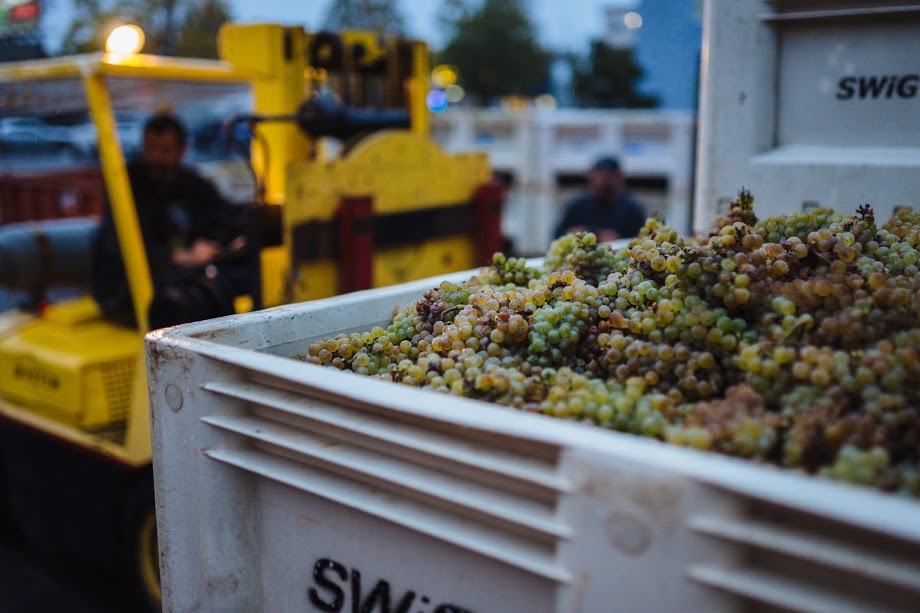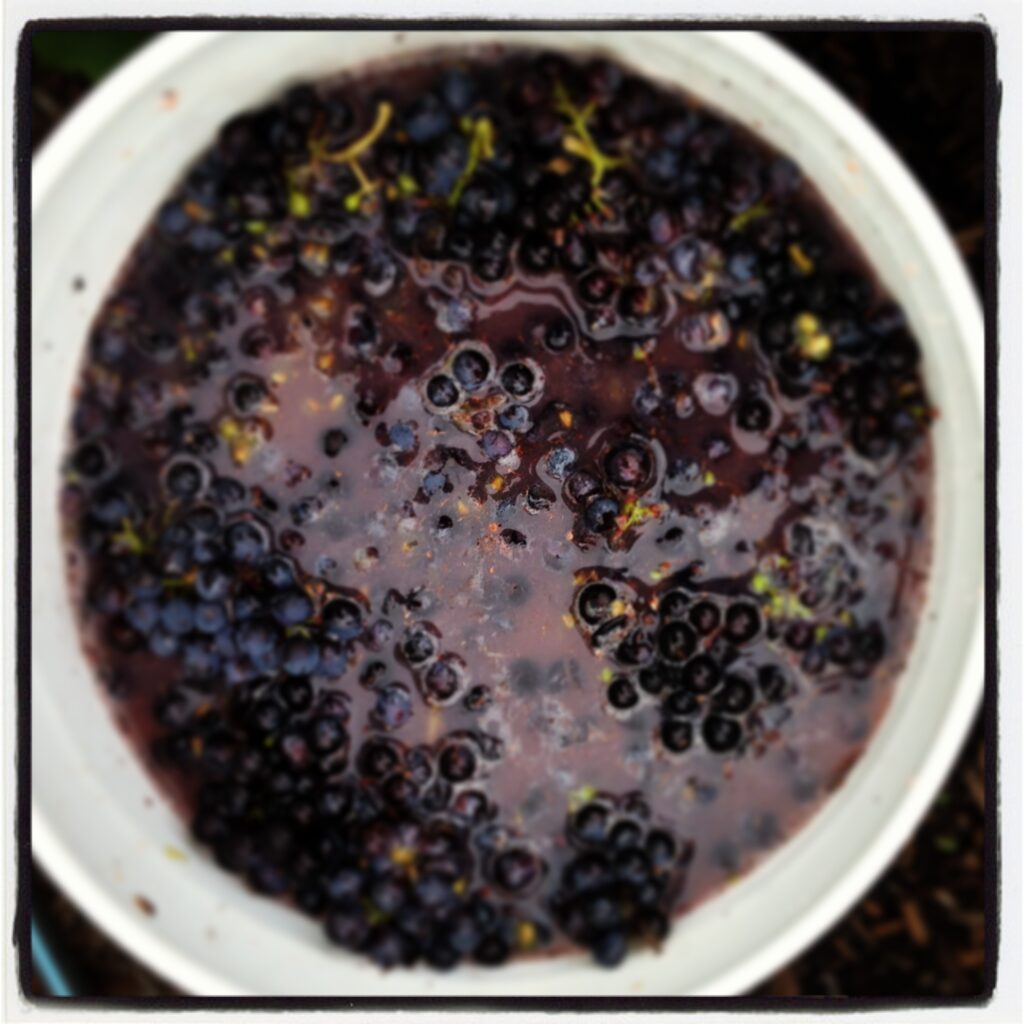
One question we get asked the most is “How did Teutonic get started?” to which I say “It’s a long story. Do you want to hear it all?
Teutonic came to be with no real plan and neither of us had any experience in the wine industry. However, with Barnaby’s determination and a little luck, we were able to create a product and brand identity that is influenced by Barnaby’s inspiration and love of German Rieslings.
It was 2002 when Barnaby was the general manager and wine buyer at Papa Haydn restaurant, one of Portland’s favorite long-standing institutions. German wine importer, Ewald Moseler, brought 14 different Rieslings he imported from the Middle Mosel, for Barnaby to taste. This was Barnaby’s Ah-ha moment. He was so blown away by how each Riesling tasted so different from one another, considering that they were from the same region and the same variety. The terroir in the Mosel is composed mostly from slate, rocks and very little dirt. There are several different slate colors and each one produces a different flavor profile for the grapes. There is blue, red and grey slate, each with its unique flavor palate. Depending on which slate composition the vines grow on, their varying tastes can be dramatic. Barnaby bought all fourteen Rieslings for his wine list, creating Portland’s most extensive German wine program. That evening he came home and announced to me, “I’m going to need to quit my job so I can learn how to make wines that inspire me like these Rieslings from Germany.”

In 2005, a unique opportunity fell into our lap. Barnaby and I were having dinner with family and friends. I was busy chatting with the person next to me when Barnaby tapped me on the shoulder and said “Hey, Gisela said we can plant grape vines on her farm in Alsea. Isn’t that great?!!” I must have nodded, as I don’t even recall this micro conversation because the next day, Barnaby called me at work and asked me which credit card should he use. “For what?” I asked. “For the grape vines I’m about to buy. You know, for the vineyard we are going to plant in Alsea. I told you that last night.”
Later that year, we had two thousand vines in the ground at a little farm in Alsea, Oregon, just 19 miles from the coast as a crow flies. We had no vineyard experience, equipment or financial backing. For the next three years, Barnaby and I and sometimes friends (when we could convince them), would drive down on weekends to mow, prune, hedge, spray, plant ground cover and leaf-thin our two acre vineyard.

By 2008, Barnaby was really itching to make more wine than the small amount he was making with fruit we bought at a U-pick farm in Canby, which he would ferment in glass carboys with commercial yeast. So his next big move was to leave the restaurant (steady paycheck) and take a job as a cellar rat at a winery (half the pay) in Carlton, the heart of Oregon’s wine country. He learned how to drive and fix a forklift, clean barrels, climb up barrel racks stacked 14 feet high to top off the wine, and clean virtually everything in the cellar. In the fall of 2008, our Alsea vineyard produced our first crop and we were able to make just a few barrels of wine. Later, the following year, after the wines where finished and bottled, we had a lot of wine to sell. That’s when we realized, we needed to form a company and begin our lives as winemakers, sales people, publicists, accountants and all the other hats we have to wear.

Today, we make between four and six thousand cases a year. The varieties include Riesling (of course), Pinot Noir, Pinot Meunier, Pinot Gris, Pinot Blanc, Gewürztraminer and recently we added Viognier and Grüner Veltliner to the line up. Barnaby also likes to create blends and experiment with fermenting in amphorae, whole cluster versus de-stemmed fermentation, extended skin contact and adding flor yeast from one barrel to another. While we still make wine from the vineyard in Alsea, we also source fruit from other vineyards around the Willamette Valley. It’s important to us that we only work with vineyards that are dry-farmed (no irrigation) and ideally have older vines (20 years or older), are planted in a higher elevation making them cooler than other sites, allowing the fruit to hang longer on the vines without over-ripening with the sugar levels, but allowing them to develop physiologically for more complex flavors. In the winery, we only use wild yeast we source from each vineyard site, creating a pied de cuve (a traditional French technique for making a yeast starter) and use only the yeast from the vineyards to ferment the wines. Our fermentation vessels include neutral oak barrels, clay amphorae and traditional fermentation bins for the reds (primary fermentation only) and then they go into barrel. We made this easy to remember by adding on our back label “Old & Cold, High & Dry, Wood & Wild.”

Since 2009, we have also been managing a really amazing vineyard just thirty miles south of Portland. The Wahlstrom Vineyard is planted on a decommissioned gravel quarry which consists mostly of rocks, gravel and basalt. The ground here is so perfect for growing wine grapes, in addition to Pinot Noir, we just had to plant some Riesling on the steepest part of the vineyard which we call “Slayer Block.”
Regardless of which wines Barnaby makes, the wines are consistently delicious, food friendly and priced competitively for the wine market. We are thrilled that some of our wines have landed on top-rated restaurant wine lists across the country.
We hope some day you can come visit us, but unfortunately right now during the Coronavirus pandemic, we are only open as a bottle shop. You can come in and browse and our Wine Club Manager Leslie will be available to answer questions and help you pick out wines. Check back with us periodically to see if we have any updates for our visiting hours.
Thanks for taking the time to read about us. Stay safe, be well and drink good wine.
Cheers,
Olga & Barnaby Tuttle
Proprietors
